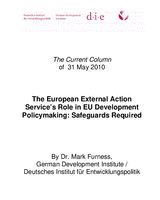The European external action service’s role in EU development policymaking: safeguards required
Furness, MarkThe Current Column (2010)
Bonn: German Development Institute / Deutsches Institut für Entwicklungspolitik (DIE) (The current column of 31 May 2010)
Bonn, 31 May 2010. The Lisbon Treaty, which entered into force on 1 December 2009, requires that EU foreign policy does no harm to development objectives, while calling for development cooperation to be conducted within the broader framework of external action. The Treaty entrenches development policy as a ”shared competence” under the mandate of both High Representative for Common Foreign and Security Policy (CSFP) Catherine Ashton and Development Commissioner Andris Piebalgs.
The EU Council approved Ashton’s proposal establishing the European External Action Service (EEAS) in late April. The intention is to improve the links between development and foreign policy, combine the European Commission’s technical expertise with the Council’s political weight, and thus increase the EU’s global role. Development policy will not be as strongly ring-fenced as before the Lisbon Treaty and clear institutional safeguards are needed if the Treaty’s letter and spirit is to be observed in three areas:
First, the EEAS must facilitate policy coherence for development
Ashton’s proposal envisages that the priorities of the Common Foreign and Security Policy will inform development policy and vice-versa. The risk that short-term political or economic interests will overshadow development objectives should not be overstated. It makes sense for the EU to put development at the forefront of its external action rather than policies where its capabilities are limited. This is of course no safeguard – robust measures promoting policy coherence are needed to reduce development’s vulnerability to crisis politics.
Second, the EEAS should be part of a coordinated intra-EU development cooperation structure.
The EEAS will share responsibility for programming the EU’s Official Development Assistance (ODA) instruments with the Commission’s Directorate-General (DG) for Development. ODA programming documents are to be prepared by the EEAS working closely with Commission colleagues under the ”direct supervision and guidance” of Commissioner Piebalgs. However, Ashton’s proposal does not clearly delineate the EEAS’ and the Commission’s roles on the key coordination questions of who will set the agenda and how the Commissioner will exercise oversight.
Third, the EEAS must be accepted as legitimate.
Although EU officials are careful to refer to the EEAS as a ”service” and not an ”institution”, Ashton’s proposal establishes ”a functionally autonomous body”, treated as an ”institution” within the EU’s financial regulation. It is unclear how the EEAS will be controlled once it is established as a policymaking body. Furthermore, the European Parliament, which must give its consent before the EEAS becomes operational, rejected the proposal due to concerns about the role of the Commission and Parliamentary oversight of senior EEAS appointments and decisions involving Community funds.
Replacing Ring-Fences with Safeguards
The European Commission is the appropriate body to ensure that development is safeguarded as its responsibilities for managing ODA are enshrined in the EU Treaties.
DG Development should retain influence over policy decisions concerning the EU’s ODA instruments. Ashton’s proposal states that Commission and EEAS staff will work together on the first three programming stages, and that proposals will be jointly submitted to the College of Commissioners, effectively creating a ”dual key” (or veto) over ODA programming. There is no formal statement that the dual key will operate throughout the process and not only once a proposal is on the table. There is also no indication of what would happen in rare cases of disagreement – whether the College of Commissioners or the Foreign Affairs Council would have the final say.
The Commission also needs to strengthen its independent monitoring function so that coherence, coordination, ownership and effectiveness issues are reported from a development perspective. EuropeAid staff will be on the ground in EU delegations, and need to be able to influence the dual key through clear lines of communication to policymakers in Brussels.
The Commission’s policy and monitoring roles would be strengthened by institutionalising the “power of the purse”. A merger with EuropeAid would increase DG Development’s control over operational budgets and thereby its political relevance.
”Soft law” has long guided EU development policy and it is understandable that Ashton’s proposal leaves certain processes to be bedded in over time. Nevertheless, formal institutional protections to keep development at the forefront of the EU’s external policy should be there from the outset. Clarifying DG Development’s role would foster policy coherence, improve coordination, and facilitate consensus among the European External Action Service, the Commission, the European Parliament, member states and partner countries.
Development Power Europe?
The Lisbon Treaty marks a milestone in the emergence of the EU as an international actor. The blueprint for achieving a greater global role is not to try to ”speak with one voice” on every issue, but to focus on the EU’s strengths in policy areas where it can make a difference. As a development actor the EU has huge resources and more reach than individual member states. The EU is also better at repetitive legalese than at mobilising hard power. This does not capture headlines but is essential for pursuing global development objectives.
The full implications of the Lisbon Treaty are not yet clear, but the trend towards integration in EU external relations, development and foreign policy is real, and development will have an increasingly important role. Many of Europe’s foreign policy and security interests are also development issues: state fragility and illegal migration are just two examples. Those tasked with designing the EU’s external relations architecture have a unique opportunity to serve global development and European foreign policy goals simultaneously. Clearer institutional safeguards for EU development policy would make an important contribution on both fronts.

